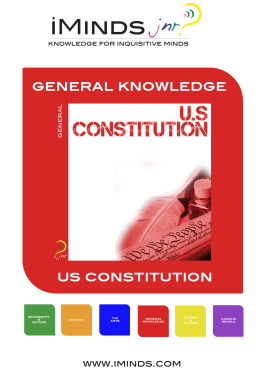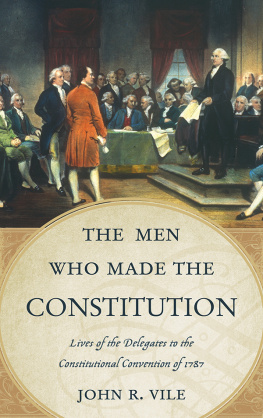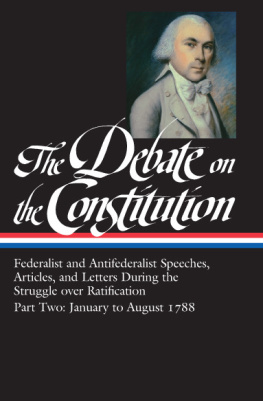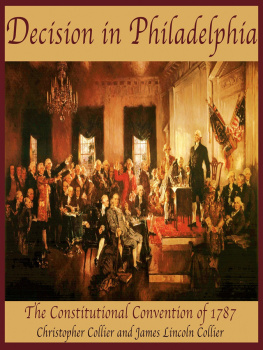To the memory of my mother,
Charlotte Rose Winterer Rubbelke
(February 23, 1917November 8, 2009),
and my fellow historian, mentor, and dear friend,
Thomas N. Brown
(April 27, 1920October 23, 2009)
POSTSCRIPT
 In Memoriam
In MemoriamIn the pages of this book, the dead seemed at times to rise from their graves to repeat lines that had earned them a place in American history, a place many of them never received until now. It feels wrong to close without knowing what happened to at least some of them after the ratifying conventions adjourned.
Those who later served in national office are the least obscure. James Iredell was well rewarded for his services at the North Carolina convention in Hillsborough: In February 1790, President Washington nominated him as an associate justice of the Supreme Court. His fellow justices included ratification veterans James Wilson of Pennsylvania, William Cushing of Massachusetts, and Chief Justice John Jay, whose place would later be taken by Connecticuts Oliver Ellsworth. Iredell was delighted with the appointment, which he thought would free him from traveling from court to court in North Carolina to cobble together a decent living. Unfortunately, early Court judges had to ride circuit, and Iredell was assigned the extraordinarily long and arduous Southern circuit through North Carolina, South Carolina, and Georgia.
His position as an associate Supreme Court justice gave him an opportunity to hear Patrick Henry at court. Iredell seems to have had a bad impression of Henry, and he was agreeably surprised. Gracious God! Iredell wrote afterwards, he is an orator indeed! Henry spoke with the most ease, the least embarrassment, the greatest variety, and with an illustration of imagery altogether original but perfectly correct, Iredell reported; and he never said anything personally offensive. In the end, after spending time with Henry, Iredell concluded that he was a much more solid character and better reasoner than I expected. Clearly men could not be judged in the light of Party Prejudices.
Eventually the justices rotated circuits, but Iredells duties still kept him away from his family for extended periods of time, and the rigors of eighteenth-century travel ate away at his frail health. In the end, they killed him.
He had survived Wilson, who, in July of 1798, also died in Edenton, in a small Carolina inn, broken, impoverished, and humiliated after two stints in jail (while still an associate justice of the Supreme Court) for debts from ambitious land speculations that had gone horribly wrong. Barely recovered from malaria and suffering the aftereffects of a stroke, Wilson died a month short of age fifty-six. The contrast between the brilliant man who had held his nose high in Philadelphia, whether or not to keep his spectacles in place, and the pathetic circumstances of his death made the last years of his life an epic tragedy. His colleague Justice Iredell had him buried on the estate of Iredells brother-in-law, Governor Samuel Johnston. There Wilson rested until 1906, when, finally, Philadelphia reclaimed his remains.
George Washington survived both Iredell and Wilsonand also his neighbor, George Mason, who died peacefully at home in October 1792. He also outlived Patrick Henry, who in June 1799 succumbed to stomach cancerbut not by much. Washingtons wish to leave the presidency quickly came to nothing. He served a second term, then issued a final farewell to his country. Iredell recorded the bittersweet mood at Washingtons birthday celebration during February 1797, when everyone knew the president would soon leave office. The first lady was moved to tears; the president felt emotions too powerful to be concealed. Washington lived only a little over two years back at Mount Vernon, until December 1799, when, at age sixty-seven, he died, quite suddenly, of a virulent throat infection. That was not enough time for him to settle his affairs, get his plantation house up to standard, make his farms profitable, or even to complete the agricultural experiments that gave him such pleasure.
Washingtons storylike that of Alexander Hamilton, who died after a duel with Aaron Burr in 1804, and Madison, who lived until 1836, when he was the last surviving member of the federal Conventionhas often been told. Those of others, who came out of obscurity for a brief, brilliant moment in 1787 or 1788, are less familiar.
Take William Symmes, the young attorney who stood up to his old law teacher, Theophilus Parsons, at the Massachusetts ratifying convention and noted the flaw in Federalist claims that to weaken Congress would be to weaken the people. Symmes never had the brilliant public career for which he seemed destined. His constituents in Andover, Massachusetts, most of whom did not think well of the Constitution, might have resented his yea vote on ratification. Or maybe he just found practicing law in rural Andover a hard way to make a living. Whatever the reason, in the fall of 1790 he hung his shingle in the growing commercial town of Portland, Maine, where he became a leading member of the bar. Symmes occasionally wrote essays for
Zachariah Johnston, whose speech endorsing the Constitution seemed to some the best at the Virginia convention, exceeding even those of Patrick Henry, remained a member of the Virginia legislature (and an enthusiast for developing the Potomac River) until a few years before his death in 1800. He was also an elector in the first presidential contest, but chose not to run for Congress. Perhaps he wanted to remain nearer his many children, to whom he had expressed so deep a commitment.
Other backbenchers like Jonathan Smith from Lanesborough, Massachusetts, whose heartfelt endorsement of the Constitution seemed to move the convention in Boston, or Amos Singletary from Sutton, Massachusetts, both of whom served several terms in the state legislature, are all but forgotten. They were part of the rank-and-file that made town democracy and representative state government work. Only rarely do their words survive outside the records of their state ratifying conventions unlesslike Singletary, who had complained about monied men, fancy lawyers, and this here self-same constitutionthey had a peculiarly memorable way of expressing themselves. The historian of Singletarys home town told a story about him from a period long before 1788, when the town was shaken by a religious revival. A local manufacturer of hoes being under concern of mind caught sight of Singletary, who was a justice of the peace and an earnest Christian, and called out to him: O Squire! O Squire! What shall I do to be saved? Singletary had scarcely brought his horse to a stop when he answered: Put more steel in your hoes. The man never spent a day in school, but he was no fool. He died in 1806, in his mid-eighties.
The political careers of both Gilbert Livingston and Melancton Smith peaked at the New York ratifying convention. Later both served briefly in the state legislature, but neither held further public offices. Smiths yea vote had allowed him a safe return home in the summer of 1788, but being in New York City still had its perils. He was the one of the first to dieat age fifty-fourduring the citys 1798 yellow fever epidemic.
Smiths convention colleague John Lansing, who in 1788 kept faith with his party and no doubt his conscience by voting nay, lived longer than Smith and held more public offices. He became a member of the state supreme court in 1790 and later its chief justice. In 1801 he replaced his old convention opponent Robert R. Livingston as the states chancellor, an extremely distinguished judicial position that he seems to have acquitted honorably. (Reports that Lansings knowledge of the law was not extensive,
Next page







![Jay John - The Federalist : a collection of essays, written in favour of the new Constitution, as agreed upon by the Federal Convention, September 17, 1787. : In two volumes. Vol. I[-II.]](/uploads/posts/book/76130/thumbs/jay-john-the-federalist-a-collection-of-essays.jpg)


